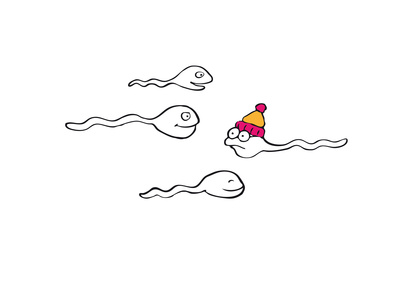
How does it actually work … with the little tadpoles?
For those who haven’t studied in the field of medicine, do you know what really takes place during ejaculation? As a non-physician and a woman, I certainly don’t know all the medical details. I only know that it happens and that several million tadpoles escape. But what goes on exactly? And what percentage of semen is actually made up of sperm cells?
The name, ejaculation, already describes the process well enough: the Latin word ejaculari means to eject. In other words – a physiological process involving the peristaltic ejection of sperm out of the urethra. An involuntary reflex. Source: Wikipedia. Okay, so I already knew that much.
The Basics
In order for this to happen, the muscles of the erectile tissue and pelvic floor, as well as the spermatic ducts and the seminal vesicles, are used. Here it’s important to note the difference between emission and expulsion. Sounds a lot like sports, doesn’t it?
First, the muscles transport the sperm cells out of the epididymis, through the spermatic ducts and gonads, mixing the cells with a glandular secretion (emission). The rise in pressure in the prostate gland and urethra causes the pelvic floor muscles to contract and eject the semen (expulsion). To make sure the semen doesn’t flow back and that no tadpoles are accidently left swimming in the urethra, the muscular systems shuts all doors.
With me so far?
Misconceptions
Most men (and probably most women as well) assume that orgasms and ejaculation are one and the same. But… that’s not true, far from it.
It is possible to ejaculate without releasing sperm cells, like, for example, after a vasectomy. The ejaculated secretion simply has zero tadpoles swimming around in it, everything else is completely normal.
There is also the possibility of ejaculation with infertile sperm, as with boys just reaching puberty. Their bodies do indeed produce those tadpoles, they’re just not matured yet.
There are also orgasms without ejaculation called dry orgasms and part of a Taoist sexual practice. Medically questionable.
In addition, there is the inability to ejaculate; called anejaculation and could be caused by illness or physical problems, such as blockage of the seminal ducts, lack of seminal fluids, prostate gland disorder, etc.
System Failure
As with all systems, the male reproductive organs are not without their fair share of malfunctions and disruptions. They occur surprisingly often and range from premature ejaculation to retrograde ejaculation, which is when semen flows backward into the bladder, and the uncontrollable flow of seminal fluids. Even medication can influence ejaculation.
Some men actually become sick after ejaculation; they suffer from a high body temperature, increased sweating or shivering, weak concentration, exhaustion and fatigue. This very rare postorgasmic illness syndrome can last for up to 7 days.
And the little tadpoles?
It’s difficult to say just how many sperm cells can be found in the ejaculation at the end. The number can also vary depending on the frequency of ejaculations. There are between 20 and 40 million sperm cells per millilitre. He who saves, has more. He who gives freely, has less per ejaculation, because he just has less seminal fluid saved up.
Image: www.wissen-wiki.de